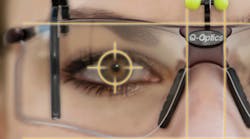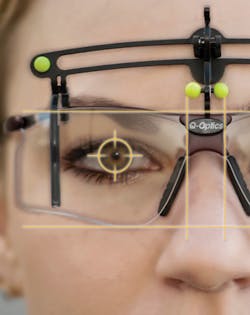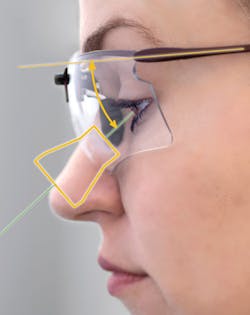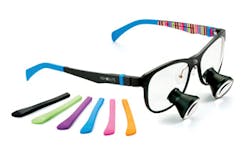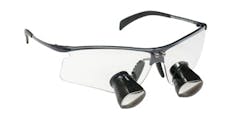To see or not to see. That is the question!
By Tricia Osuna, RDH, BSDH, FAADH
Approximately 16 years ago, dental hygienists engaged in numerous discussions about using magnification lenses. At the time, two camps participated in those conversations: those who believed dental hygienists should wear magnification and those who were adamant that they were not needed.
In 2016, we have observed an amazing change in the acceptance of loupes, as well as lights, in clinical practice and educational settings. For this article, the focus will be solely on loupe purchase and measurement information gathered from various manufacturers. Understanding the nuances of the different products on the market and what to look for will aid those who may be confused by a sales pitch or have not yet been educated on what is important to know when ordering loupes. I fell into this category and found it helpful to have additional information when making a decision about my purchase.
Typically, loupes are purchased for specific reasons, such as improving vision, also known as visual acuity, and protecting your body, also known as musculoskeletal protection. Dental hygienists should understand what they will gain from using loupes, and this awareness impacts the purchasing decision behind choosing the right product.
The lack of a need to improve vision has been discussed often by hygienists who have been in clinical practice for a period of time and who are doing "just fine" without loupes. I shared the same belief, since I performed just fine clinically. Why would I add those lovely glasses to my life? After I spent the time to learn more about loupes, I understood the true value and benefits. Also, many clinicians believe that once they start wearing loupes, their vision will decline. This blanket statement is a misconception by many clinicians. Vision changes beginning around the age of 40 are a normal process of aging and are not a side effect of using high quality loupes.
The Parts
When purchasing magnification, keep in mind the three main components of loupes: frame, carrier lens or shield, and loupe (also known as an ocular or telescope).
Resolution-What you should see when looking through a loupe depends on the quality of the loupe lenses themselves. It is recommended by many that the initial magnification size be 2.5x. With advancement in technology from 16 years ago, optics have greatly improved. There are differences in optical clarity between companies; however, several manufacturers offer high resolution telescopes providing a precise and clear view of the mouth.
Custom TTL (through the lens)-We are now in the second generation of products that are widely accepted-through-the-lens, often referred to as TTL. TTL describes the loupe being mounted and secured directly into the lens. The first generation, flip-up, offered an uncustomized loupe mounted on a bar with a hinge attached to the frame. The clinician adjusted the loupes to match, as close as possible, where their pupils were and had the ability to flip them up and out of the way.
By nature of their mechanisms and manufacturing, flip-ups are much heavier than TTL. However, they contain the same loupe, just mounted differently. I personally prefer TTL, having tried flip-up loupes, and know that many of my colleagues have switched to TTL over the years.
Customization has exploded in recent years and will continue to advance. TTL loupes are customized specifically to the clinician, whereas flip-ups are not. It is a personal choice, so understanding the difference between a customized product and uncustomized product is important.
Loupes-In the process of producing a custom product, there are measurements that need to be taken and used in manufacturing of the loupes. These measurements can be taken at a dental conference or in your office, provided the company has a local representative. Being measured for higher quality loupes at a convention or meeting is perfectly acceptable. Pupillary distance, working distance, field depth, and declination angle are all measurements to be knowledgeable about for purchasing reasons.
Pupillary distance (PD) is the measurement of the distance between the pupils, as well as the height of each pupil. Using the PD measurement, loupes are custom mounted to match where a clinician's eyes can easily use them. Knowing that we are not symmetrical beings applies to this measurement! The PD measurement should position the loupes appropriately so the clinician's eyes do not have to "work to find them." The process to secure a PD is usually done with a pupilometer. An advanced technique used by a few companies involves photographing clinicians wearing a frame with a measuring indicator, which further customizes and creates improved accuracy for loupe placement in the lens.
The pupilometer measures pupillary distance.
The declination angle is the downward tilt of the loupes.
Working distance measures from the front of the eye to the most distal portion of the patient's mouth while your arms are at or near 90 degrees. As J.J. Keegan states, the most favorable ergonomic operator position is such that the forearms are within 5 to 10 degrees of parallel to the floor, and both the hip-to-thigh and popliteal arch (behind the knee) angle are at a minimum of a 110 to 135 degree opening.2 This results in the knees dropping slightly below the hips.This makes for a nice, long, and healthy career! This measurement is designed to place you in the most neutral posture possible for musculoskeletal protection. The working distance is then built into the loupe so you can see clearly while in your neutral posture.
Depth of field considers where you might need to be positioned for a variety of patients. Magnification of 2.5x allows clinicians slight variability without compromising the body too much. Moving out of the depth of field results in a blurry image. Your brain registers that and sits you back into the neutral position.
Declination angle is the downward tilt of the loupes, another critical component in protecting your musculoskeletal system. To select the ideal declination angle, the operator should assume the most favorable ergonomic position and the lenses of the loupes should be inclined so that the head has a slight tilt for viewing the work site.1 An incorrect declination angle can lead to increased neck and shoulder pain, along with migraines and additional ergonomic trauma.
With the ability to customize loupes and the declination angle, the future promises a continued emphasis on proper ergonomics.
Frame selection-Important considerations when considering frame selection include frame structure, comfort, and eye coverage. Are the temples hinged? Are you able to adjust the temple tips so they fit securely? Do you need to wear side shields, or do the lenses meet OSHA standards for protection without side shields? What type of nose pad does the frame have? Is it a molded frame with no option? Does it have a standard nose pad that can be adjusted to fit your facial features best? Does it offer an added bridge for those that have issues wearing any glasses at all? These are all options available in the fit of a frame. Remember, not all frames are created equal!
One of the most important features in a frame is comfort. Clinicians will be wearing these all day. I suggest you try them on and wear them for a while to see if they will work for your facial structure, protect you from aerosols, and accommodate your individual needs.
Despite popular belief, frame selection is not all about fashion. Having been forced in school to wear the infamous white dress, white nylons, white shoes, and ever-so-lovely white cap, I am not concerned about the lack of fashion in dentistry; for me it was never there! Now, we wear scrubs, cover them with gowns, add a mask to hide our faces, put on some sort of safety glasses, then don gloves, so...what does fashion really matter? Adding a high quality resolution loupe to my eyewear to have such an amazing benefit matters more to me than what the frame itself looks like. I realize we have different opinions on this topic, as do the manufacturers! Today, you will see a variety of styles in frames from shape, weight, protection, and even the ability to add color to your frame.
Another consideration when looking at frames is customization of the carrier lens. Does the company have the ability to trim the lens to customize the fit? If not, I would encourage you to search for a product that truly fits your facial features to ensure you will be comfortable wearing them for several hours each day.
While fashion should not be your primary focus, it always helps when a loupe manufacturer offers frames in a wide variety of models, colors, and sizes to match your personal style. Some of the best loupe frames are those designed by loupe companies themselves, for the specific purpose of assembling loupes.
Warranty-There are three parts of a pair of loupes-frame, lens, and telescopes. There should be individual warranties for each part. Inquire with the manufacturer about what they are, and be sure you are provided adequate information for the purchasing decision. Loupes should last for many years. When I hear a company state they offer a 90-day warranty, I cringe. There is a variety of warranty plans, ranging from 90 days to a lifetime on each part. Don't be afraid to ask what is not covered under a lifetime warranty, or what is not covered under any warranty.
Additional considerations-Does the company offer anything additional to their loupes and, if so, do they upcharge for it? Some items to inquire about are antiscratch coatings, antireflective coatings, antifog coatings, and prescriptions. Are they standard, or an additional fee? What is the fee? What are the prescription limitations?
Be sure to take notes when discussing prescriptions. Various manufacturers may have different capabilities with placing prescriptions. If it is a distributor that sells parts assembled for what I call "noncustomized" TTL loupes, you will have the fewest options. Also, depending on the curve of a lens, you may have a limitation to nothing higher than a -4.00 Rx, and so on. Some companies are able to place your prescription into the carrier lens only, while others are able to build it into the carrier lens and the loupes.
When researching prescriptions, investigate a removable insert. Again, there are very few companies offering these. Prescription lenses are mounted to a nose pad, all as one piece that you slide into the loupes. When you wear your contacts and do not need a prescription, you simply remove the nose pad/lens and place a nose pad for use. You have a simple nose pad to insert when you don't need your prescription as you are wearing contacts. When you do need to use contacts, the nose pad is removed and the insert with its own nose pad is placed.
Other information to know is how do you change the prescription? What is the fee to do that? If you have to send the loupes in for this, how long does it take? You will want to know how long you will have to provide clinical care without your loupes!
Purchasing considerations-When talking about the specifics on price, the dollar amount is not as important as you may think it is. Once you select the product that meets all of the criteria, you will understand what I mean.
Most companies offer a 45-day trial period. During this time, you are able to use the product in your practice setting to truly understand how it works. Many companies also offer a payment option. Specifics to ask on payment options are: How many months are you able to spread the payment over? Are there interest charges, and if so, what are they? Are you charged the day you order or the day they are shipped to you? What are the shipping fees? After the 45-day trial period, are you able to return the loupes and receive a full refund, or must it be done prior to the 45th day? What are any other costs that you might be unaware of or that have not been discussed?
I always recommend using the longest, interest-free payment option. This allows you time to pay off your loupes while you are still getting used to them and feel less pressured into the experience.
The Future
Smaller, compact telescopes are becoming more popular among dental professionals. These new "micro-optics" deliver lightweight comfort, but often at the cost of field size. When considering a micro loupe, make sure to evaluate the field width and depth to ensure it is adequate for your everyday usage.
Recently, loupes with multiple magnification power in a single product were introduced to the market. The technology in this product allows the clinician to zoom in and out to customize the magnification according to the procedure. A typical perio probing, for example, would most likely be completed at a lower power. However, an endodontic procedure would be done at a higher power. Variable magnification telescopes do require more lenses to function; therefore, they are a bit heavier than traditional loupes.
As you can see, purchasing magnification is not something to move quickly with. Failing to take all aspects into consideration could result in a pair of loupes that sits in the case and are rarely used. Remember, this is an investment in your career; therefore, it takes time and understanding of the many parts of the products, as well as options on the market. RDH
Tricia Osuna, RDH, BSDH, FAADH, is a University of Southern California graduate and past president of the American Academy of Dental Hygiene and California Dental Hygienists' Association. She is a previous member of the Dental Board of California, and founding member of the American Board of Facial Esthetics. Her career spans a variety of roles, including consultant, clinician, educator, international presenter, author, mentor, and business owner.
References
Michaelides P. Use of the operating microscope in dentistry. J Calif Dent Assoc 1996;24:45-50.
Michaelides P, Stambaugh R. Boosting your optical acumen. Dimensions of Dental Hygiene. 2005;(4):16-21.
